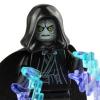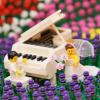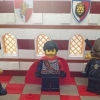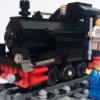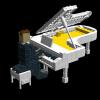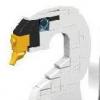Search the Community
Showing results for tags 'piano'.
Found 15 results
-
As a HUGE lifelong fan of the Muppets, the upcoming CMF line will -- assuming the rumors are true -- be the first one I collect in its entirety! Coincidentally, I've just learned to use Studio 2.0 from BrickLink and thought I'd share a few pending creations. My first design is a "Muppet arches" frame for all 12 figures. I don't have the space nor the disposable income to afford a large-scale stage set, as some other designers are doing -- impressive as some of them are! This design is centered on the arches alone, with a base and top detailing meant to be more evocative of the Muppet Theater than a literal depiction of it. (Because it's so narrow with lots of single-stud connection points, I'm wondering how stable it will be in real life; I plan to see about reinforcing those stacked round bricks with interior rods, and I have a backup plan to extend the sides in the back with some black scaffolding if it seems prone to topple.) My second design is Rowlf's piano. Because my Girlfriend is particularly fond of Rowlf, I plan to snag a second figure to add to a vignette that she can keep at her own piano. Rowlf plays a few pianos on the show; my design is based on the upright model, because it was simplest in terms of design and most efficient in terms of space. I'd have preferred a slightly different shade of brown -- perhaps dark brown, to better contrast with Rowlf himself -- but reddish brown was the only color that had all the parts I needed. Anyway ... I'm particularly pleased with how the book is integrated into the piano to hold up the sheet music. (And I may swap out the hair on the Beethoven bust, as pictured. We'll see how it looks IRL!) Feeback welcome! And here's a link to the IO files, if anyone wants them. P.S. If the leaks are correct, I'm not happy with the choice of outfits for Gonzo. I'd have much preferred his classic maroon tux! I'm thinking I may swap in the dark red Harry Potter goblin torso from set 4714, along with matching legs and perhaps a black bow tie piece (though even if it covers the tiny one, it may not fit the overlarge head). It's not a perfect match for the original show, but it comes closer than any other part I could identify. (As an alternative, President Business's argyle sweater vest is a reasonable approximation of Gonzo's outfit circa The Great Muppet Caper and The Muppets Take Manhattan, though it would be more accurate if it were gray rather than sand green.)
-
This set is truly awesome. I am at the stage where the key cover has to go on and I have hit a wall. It will attach and close, but it will not open all the way. The black keys are preventing it from being able to fully open. Anyone else experience this issue? Any and all advice is welcome...TIA
-
Piano is not my forte. The end. Oh, you're still here. Okay. Let me try again. The statement above is a joke but it is also true. No pun intended. This review is about the Grand Piano set, a LEGO scale model with ornate details inside and out. If you were around back in April, my last review was about the immaculate 1-piece LEGO white baseplate. Today, I am about to review a set with over 3600 pieces. Not much of a difference, really. Now, let's begin with my 32nd RA review, set# 21323 Grand Piano. Overview Name: 21323 - Grand Piano Theme: IDEAS Year: 2020 (2H) Pieces: 3662 Minifigures: 0 Price: USD 349.99 / EUR / GBP 319.99 Introduction I have very fond memories in my childhood wanting to play an upright piano whenever my mom and I visit my aunt's house. In fact, I have a picture of me pretending to play that piano -- it is one of my favourite childhood photo. Sadly, the untapped potential got wasted because I never had any proper training to play a piano, or any musical instrument for that matter. I don't think I could ever read sheet music as that take years of practice too. I only understand music alphabets - those 7 letters A, B, C, D, E, F and G. Regardless, I enjoy music and I am one of those person who could listen from rock music to gospel song, then to jazz, switch to EDM, then back to classical symphonies. I love music and that's why I appreciate this set that celebrates the art of music. With this LEGO set, I could fool you into thinking that I am also an expert musician. I am not kidding. I will be expertly playing Fur Elise like Beethoven himself, towards the end of this review, so keep on reading. Before proceeding, let me thank TLG and Eurobricks for giving me the opportunity to review this remarkable set. All opinion about this set is my own. Front Box Panel The new branding of 18+ looks very premium especially with the gold font used in the grand piano branding. It just exudes class. Side note -- for some reason, the gold and black colour scheme reminds me of a Belgian chocolate brand. Back Box Panel The classiness continues at the back. The back panel shows the dimension of the grand piano, as well as the Powered Up components featured for its auto-play feature. There are minimal text in the packaging so it is not explained how this feature works. More about that later. If you have not bought the set yet, I encourage you to know how the play function works first before making any purchase because it could lead to disappointment if you don't do any homework or research. Now, let's carry on. Carry on, it doesn't even matter... (for the mostly parts) The box is a lift-up type similar to that of the recent Technic sets such as 42115 Lamborghini Sian. While looking premium, the box is so huge that 4 tapes are needed to seal the box. I wonder how long the seals are going to last. What’s inside the box? There is a box within a box. I am not tracking how many such LEGO sets have this kind of packaging -- but when I do see one, it means serious business. Really serious. Below, you can see the contents of the smaller black box laid down. The other half remained inside the bigger box for the time being. There are are so many pieces that I cannot take picture of them all in one go. Instruction Booklet For a set this expensive, I already expected there is no sticker sheet. Indeed, there is no sticker sheet in this set, and I prefer it that way. The instruction book looks very good but I am not keen on using this for building reference. I thought that it would ruin the bindings because the instruction book is too thick and I don’t want to ruin it by flipping it over and over. As you can see from the picture above -- it is 2 bricks tall. I decided that I will be using the LEGO Instructions app for this round. So, looking at my phone, I now have more LEGO games and apps that I could ask for. That’s because in the last 24 hours upon receiving this set, I downloaded 3 more LEGO apps on my phone. I even have The LEGO NINJAGO Movie game on PS4 which my kids and I recently got platinum trophy. These LEGO apps and games just keep on coming. LEGO is everywhere. In the playroom, in the living room, and even in my pocket. Build Starting with the build overview, the screenshot from the instruction app is a very good starting point. From bag 1 until bag 10, the focus is mainly on the frame and body of the piano. From bags 11 to 15, the focus is shifted onto keyboard, while bags 16 and 17 are meant for the fall board, music shelf and desk. Then, bags 18 to 20, are all about the lid only. Finally, bag 21 is meant solely for the chair. Ready for the long read? Adagio. Bag 1 out of 21 The interior of the grand piano is mostly tan. I like this colour and it’s the obvious choice for the frame as the cabinet cavity is mostly made of wood. Dark tan makes sense here as well. Bag #1 progress - cabinet underside and spine The first in-progress picture and it looks odd because I oriented this the wrong way. The tan side should be flat on the ground because it is the bottom of our grand piano. The black flat wall of the piano cabinet is called the spine. While building this, I am curious as to how the ball joints will be used later. More on that soon...ish. Bag 2 out of 21 I was not too familiar with the newer battery unit / smarthub so when I learned I needed 6 AAA batteries, the AA batteries that I prepared were useless. So, I needed to get spares quickly. Bag #2 Progress - Powered Up smarthub, motor and motion sensor I felt that having these electrical components at bag #2 is too early in the build. So much bricks will be added on different directions and it is very likely that these component might be locked inside this build permanently, or until dismantled. Take a good look at the arrangement of these Technic beams. All the colours point in the same direction. Bag 3 out of 21 Bag #3 Progress - Damper wires The dark bluish grey pins are meant to be the damper wire. These damper wires hold the dampers which stop the note once you release the piano keys. Just remember this for now because it is a long way before we even get to the dampers. Bag 4 out of 21 So far, this bag is full of 1x6 tan tiles, and I really like the smoothness of the build so far. Bag #4 Progress - Soundboard At this angle we can confidently say that the studless to studfull ratio is off the charts already. Bag 5 out of 21 At this point, I got confused that I could not see bag #5 from the smaller box that I have unboxed. Then, I realised that it was outside the smaller box, and inside the bigger box. Due to my confusion I almost forgot to take the in-between progress after building bag 5. Bag #5 Progress - tail Bag #5 is essentially the buttocks of the piano. Remember the ball joints earlier? With technic pins connecting the upper parts (soundboard), the job of the ball joints below is to connect the piano tail on its belly. I know it doesn’t sound right but I did not make up the names of the piano anatomy... Just remember that in case you want to take the motor out of the piano’s belly, or perhaps even its motion sensor -- you need to remove the tail cover at the back first and detach the ball joints so you can pull the tail off to have access to the cabinet cavity. Finally, the chubby tail of the piano is completed. Bag 6 out of 21 I am very pleased that there are many tan and dark tan parts in this set up to this point. However, we are mostly done with the interior of the piano, so we will see more black parts from here onwards. Bag #6 Progress - Keybed Part 1 I hope that you are learning the parts of the piano as we go along this building process because surely, I am. This section of the build is part of the keybed. This is literally where the action happens in the piano and where the piano action mechanism is located. Bag 7 out of 21 Bag #7 Progress - Keybed Part 2 Bag 8 out of 21 Bag #8 is essentially the pinblock of the piano where you can find the pins, which are represented by the pearl gold tile 1x1 with open O clip. The pins hold the string securely with the right tension to produce the right frequency for the note. What's not included in the picture are the pearl gold hoses that serves as bass and treble strings. Those are attached to the pins, on top the pinblock, in the subsequent pictures. Bag 9 out of 21 Bag #8 & #9 Progress - pinblock, pins, strings, cheeks and bent side cover At first glance you can see the gap at the bent side part of the piano. At first I was very distracted by it, but as I finished the whole build, I grew used to it.. In case you don't know what are piano cheeks, those are the ends of piano keyboard. It is built with part # 6005 brick, arch 1 x 3 x 2 curved top. At this point, you are instructed to reset the gear by pressing the encircled icon in the Powered Up app. Missing this important step might cause frustration later. The reason is simple - if you don’t reset the gear, the technic beams will be in random position so they would obstruct the keyboard rear end. The gear reset will set the beams in neutral position so you can fully slide the keyboard in. Take my word for it, I learned it the hard way. Bag 10 out of 21 Bag #10 Progress - Legs These legs are chunky, but they look proportional to the chunky grand piano as well. You have to remember, the entire weight of the piano rests on these 3 legs so they need to be strong. Bag 11 out of 21 From bags 11 to 15, it is all about the keyboard. That includes the keyframe, as well as the individual keys, and the action mechanism. Bag #11 Progress - F4 to B4 Provided the middle C in this pretend piano is C4, as it is the widely accepted middle C, then the lowest register in this grand piano build would be C3. That would be the leftmost white key in this build. But let me step back a little bit. I thought initially that the build will start from left to right but it’s not the case. The build starts somewhere in the middle left. If that makes sense. These keys correspond to F4 - B4 range. Just play along for now. The keyframe itself would be the array of plates underneath which hold the keys. Interestingly, the only connection that holds the keyframe and the keys are those conical shaped parts, which is conveniently named “ice cream cone” in Bricklink. Technically, they are not even connected. The key is simply positioned on top of the keyframe, guided by inverted ice cream cone. The gap beneath allows someone to push down the key, and this tilts the key from the top of the dark medium flesh slope like a lever. Bag 12 out of 21 Bag #12 Progress - C4 to E4 + F4 to B4 We have just added 7 more keys. That is 4 white keys and 3 black keys. These 7 keys are added on the left side of bag #11 build. Bag 13 out of 21 Bag #13 Progress - C4 to E4 + F4 to B4 + (middle C) C3 to E3 Bag 14 out of 21 Bag #14 Progress - C4 to E4 + F4 to B4 + (middle C) C3 to E3 + F3 to B3 This is the most repetitive part in the build and it does not help that you need to do different variants of the keys. It is interesting nonetheless because the end result is beautiful. Bag 15 out of 21 The last key (C2) is found in bag #15, which also happens to include the keyslip. This is the part that runs across the front of the piano which protects the keyboard assembly from sliding out. Last look inside the empty keybed. Bag #14 Progress - Complete keyboard, range C4 to C2 For reference, you may compare the keyboard layout to the finished keyboard assembly below. With 15 white keys, this keyboard features 2 octaves and an extra C note at the highest register (rightmost). Attached to the keyframe, the assembly looks like the picture above, just before sliding inside the keybed. Provided you did not skip the crucial step found in Bag #9, sliding the assembly should be easy as pie. With the keyframe fitted in, we now have the keyboard ready for action. Note that the keyslip and the keyboard, are not connected by any studs. They just slide in together. To secure the keyboard, the keyblock is secured using a technic pin that locks the left and right side, underneath the piano cheeks. Since the keyslip is connected to the keyblock, this prevents the keyframe from sliding out, and keeps the keyboard safely intact. Bag 16 out of 21 Bag #16 is the fall board or key cover. The most interesting part for me here is the single inverted tile 2 x 2 with old LEGO logo circa 1934. Bag #16 Progress - Fall board The instruction wants you to slide in the fall board or the key cover while the keys and keyframe assembly are already fitted inside the keybed. However, I find it much easier to remove the keyblock, keyslip and the entire keyboard assembly and just attach the fall board on top just as how it is pictured below. Once the cover is fitted, just slide them back inside, then put back the pin locks underneath again. Now, enjoy the key covers. The cover has a slight friction preventing it from slamming onto your fingers. With the right push, it will stay in position as pictured above. As noted by the fan designer, the fall board is supposed to have a soft close feature. Meaning, it won’t slam on your fingers because closes down gently. Bag 17 out of 21 This bag contain parts for the music shelf and music desk - the one that supports the sheet music as well as your phone if you choose to use it for the auto-play feature. Apart from this, this bag also contains the parts for the dampers. Those are the black convex shaped things that are found on top of the strings. Bags 18, 19 and 20 out of 21 Frankly I am not sure why these parts are broken down into 3 separate bags when these bags are meant for the piano lid only. That includes the main lid, front lid, as well as the hinge which connects at the spine of the piano. The parts are all black. Here they for your viewing pleasure: Bags #18, #19 and #20 Progress - Lid This is the top of the lid. I don’t think you can find a build as straight forward and smooth as this in any LEGO catalogue. The underside is just as interesting, with technic bricks running across the lid that makes the structure rigid. Once attached, the cover does a really good job in holding itself even when fully opened. However, I suggest you don’t do this on purpose because the technic bricks with pins, which connects the hinges on the piano spine, will be stressed so much with the lid’s sheer weight. Now, the moment I am waiting for -- with the lid closed down and the key cover shut, join me in admiring the beauty of the piano case and its sexy body shape. Viewed from the tail, I can appreciate the chubby proportion of the build because it is a toy. If this is a real piano, the rim height is just too high for its body. For what it is, the proportion is very toy-like. Also, can someone please let me know if there is any other set smoother than this? I checked many times. Save the 3 legs which have 4 exposed studs each, I cannot count any exposed stud in this closed-lid grand piano body. There are 2 anti-studs at the spine edge of the lid but they do not count as studs, do they? Bag 21 out of 21 Finally, we came a long way to finally build the last part of the Grand Piano set. The ultra-luxurious looking chair with a lift mechanism. This chair looks more comfortable than the IKEA chair I am sitting on right now. While the piano itself only has 12 exposed studs on its exterior, this time, I could see 2 studs on the chair - one on each side, left and right. I have never been more excited to find exposed studs in a set because it is such a rarity in this build. Viewed from side to side, and top, this set is 14 exposed studs on top only. That is over 99% SNOT perfection. Maybe I am wrong. Let me know, please. Once again, viewed from a different angle, the studs not on top design in this build is topnotch. Overall, those who supported the project in IDEAS will be very pleased. Even though the interior is changed, I don’t mind swapping the strings with rigid hoses -- but I am not sure if there are grand piano with gold strings. Maybe the bass strings could use copper colour instead because those strings are commonly using heavy copper wound strings to generate lower bass notes. As for the treble strings, I think that pearl grey or silver would be more accurate. Not really a big deal as long as the build is sturdy. So, about its sturdiness -- it is strong and well put together even if the case has a hinge at the bent side. I don't fear that it will crumble into pieces at all. Surprisingly, it is very swooshable. It can race with LEGO Speed Champions. Just make sure you race on a smooth surface because a slight bump or level change could nudge or cripple one of its legs. To further support my point on how strong it is, I had no trouble putting the piano on its side or turning it upside down. Enjoy the underside of the piano Let’s talk about play features To begin with, turning the smarthub on feels awkward at first because it opens at the unexpected direction. In my opinion, it would be more natural if opening is on the other side because the green "on" button is further in. So turn the device on, connect the app via bluetooth, select a song (very limited list) and you have yourself an auto-playing piano. I like the novelty idea very much but I don't see myself playing the piano with the Powered Up phone app because I cannot put the app in background to keep it from playing. It is such a big flaw in the app design. That means in order to play the piano songs, you need the app to be running in foreground all the time. You can't do anything else! smh... Playing the keyboard is a good experience. It feels responsive but I can tell that it does not feel like a real piano key at all. For starters, it is very light because it is made of ABS plastic. You don’t need to be a piano expert to know that a real piano key feels substantially heavier. It gets A+ for trying. The GIF above is me, randomly pressing any key to generate the melody of Fur Elise. Just note that the whole key press action is only being processed by a single motion sensor that tracks the red technic beams as illustrated in the instruction below. When you press a key, the full-length of the black technic axle will move, along with the red technic beams, which is then translated as a key press in the app. Therefore, if you press a single key for the entire song, the Powered Up app won’t even know which key you pressed because the information is reduced to an up and down motion only. You may not know it earlier while building but the step shown below is responsible for all the notes you hear on the piano. As I said at the beginning of this review, I will be expertly playing Fur Elise. So, to demo this, I mustered all the courage to record this silly "press any" performance. First part is the app demo, and the the second part is about the performance itself. Enjoy the playlist. I don't think that the oversimplified "play your own" music is an insult to pianists or aspiring musicians. It is a limitation of the tech components included in the set. To be fair, the fan designer himself is a music teacher and piano tuner, while the wife of the LEGO designer who worked on this product is a pianist and piano teacher, too. Insulting or discrediting musicians would be the last thing they will do. Just keep that in mind. Parts While the new parts are not a stand-out in this set, there are exclusive prints and new colour of existing LEGO elements. Take a look at the list below. New part/recolour list: 6322630 (11203pb055) - Tile, Modified 2 x 2 Inverted with Gold 'LEGO' Pattern, exclusive to this set 6322624 (10202pb016) - Playday sheet music 6 x 6 tile, exclusive to this set 6322135 (part 65734 in black) - first appearance in this colour. 6310833 (part 32064a in dark tan) - first appearance in this colour. 6311104 (part 32124 in tan) - first appearance in this colour 6322138 (75c32 in pearl gold) - Hose, Rigid 3mm D. 32L / 25.6cm (first appearance in pearl gold?) 6322139 (75c26 in pearl gold) - Hose, Rigid 3mm D. 26L / 20.8cm (first appearance in pearl gold?) 6173281 (75c16 in pearl gold) - Hose, Rigid 3mm D. 16L / 12.8cm (appeared 3x) 6267914 (75c12 in pearl gold) - Hose, Rigid 3mm D. 12L / 9.6cm (appeared 2x) 11212 in dark tan - appeared in only in set 75317 so far 11211 in dark tan - appeared in only in set 75317 so far 6312473 (part 15068) in medium dark flesh - only appeared in 2 other Mario sets 6294492 (part 9563 in metallic gold) Money / Gold Bar - appeared in 2 other sets only. They look like golden spaghetti strands Conclusion When Donny Chen submitted the original design to LEGO IDEAS, he outlined his main goal in the project. He wanted to capture the mechanical details of a genuine piano, featuring: Removable keyboard with 25 independent working keys, each key connects to its own hammer. Working damper and pedal function. 25 strings. Realistic piano lid which can be open either half stick of full stick. Realistic fall board with a soft close. Removable music stand. Height adjustable piano bench. Self-playing function enabled by adding PowerFunction, which allows keys to play at different tempos and rhythms. Realistic piano wheels. Overall, the final commercial product by the LEGO designer Woon Tze Chee is very close to Donny’s goals, and to some degree exceeded them even if there were some changes made in the interior and exterior design, for better or worse. To highlight a few, these are: The omission of LEGO strings for the treble strings. Likely, looping around strings does not meet LEGO standards so they were replaced by pearl gold hoses instead. The bent side is definitely better in the commercial product despite having a gap, which is necessary to open the door easily. The height adjustable piano bench is actually adjustable. The original design was not. Grand Piano legs design is slightly better because it uses plates and tiles for added detail. No chromed parts. Sadly. On the flipside, there is no paint coat that is going to crack or peel off ever. If you are a music enthusiast or a musician, there are many things to like about the set. The highlights for me are: Great representation of the parts of piano, both exterior and interior. 25 keys, which captures the essence of the piano action mechanism, such as hammer, damper and sustain pedal. Majestic looking set, which is possibly the smoothest set LEGO ever created thanks to the extravagant use of SNOT techniques. Some of the nitpicks I could think of are: The play feature is there, but it is not mandatory to enjoy the set -- majority will display this set only and may not even use the play feature anyway. The strings are not angled inside the piano cabinet, like how a modern grand piano might look like. However, thinking more about the last point, I don't think this LEGO set is trying to be one. I know that the modern grand piano design has 2 bridges, one for the treble and another one for the bass strings. These 2 would cross each other, one on top of the other at an angle, using a wiring method called overstringing or cross-stringing. This has become very common in the modern era as it allows longer strings in a shorter cabinet design. However, grand pianos before the 1800s use a single bridge scale design, without criss-crossing of strings. A simple Google search of Erard grand piano will show that this antique instrument uses an old string wiring method, similar to this LEGO model. As this set alludes to being an antique grand piano design, this is probably the reason why the LEGO designers used the oldest LEGO logo. Finally this leads me to list down some caution before buying (or not buying) the set (soon). The key press does not correspond to the right note or any particular note for that matter. Using the LEGO Powered Up mobile app, pressing any key will play back the correct note in the phone app regardless if you are pressing the correct piano key or not. Some people may find this misleading because one might think it is capable of doing that due to its hefty price. I understand the argument that a cheap electronic toy piano can play correct notes using the right key, so why can't it do the same? Not my own words, but I am just saying that some people might think this way. You cannot play your own song in the app, even if it is all pretend play. The app is also quite restrictive. As one could be building this model to display only, without the intention of ever playing it, the set could have been cheaper if the electronic parts were not included and made as an optional add-on. However, these components were included so you might as well use them for another project. Don't trap them inside the piano if you won't use them for that purpose. There are some reports that this is hard to get because it is in limited availability status at the moment. I am not sure if the stock will normalise after few weeks but keep this in mind. Do check with your local retailer for availability first. The inspiration Review summary Design / Building Experience: 10/10 - I really appreciate the countless SNOT techniques and effort to make the mechanical parts functional depicting that of a real piano. Highly detailed and educational build. My design "complaints" are very minor and easily outweighed by extremely positive results. Playability: 7/10 - In my opinion, this should have been a display model first and foremost, with optional Powered Up add-ons only. The auto-play does not really add much because the app is restricted to very few songs only. You can’t even add your own song even if it is just a pretend play. Some might think that the pretend play is misleading, especially when someone is not familiar with the limitations of the components inside. Minifigures: N/A - Not applicable / not scored Price / Value for money: 8/10 - The price per piece ratio is highly reasonable but the set could have been cheaper if the electronic components were not included. Overall: 8.33/10 - A premium set that is best displayed even if it has very functional parts. It suffers on playability and value but it is a perfect artistic model for music lovers and LEGO fans alike. Full Flickr album could be found here.
- 31 replies
-
I really love LEGO and Elton John's music, so I recreated the album cover of Goodbye Yellow Brick Road with LEGO. Part of the inspiration was the set decoration for the Farewell Yellow Brick Road tour, but mainly, I just wanted something cool for my desk. When the Systar Party Crew set introduced printed piano key tiles, I immediately wanted to make a minifig scale piano. That is where this MOC started, then it eventually grew into an Elton John themed build. Here are a few more images from different angles: Also, I posted this on LEGO Ideas, if you would like to support it you can find it here.
- 4 replies
-
- piano
- elton john
-
(and 1 more)
Tagged with:
-
Chick, you've cheated on me This is a reference to a song by polish band Kury (Chickens or Hens): www.tekstowo.pl/piosenka,kury,chryzantemy_zlociste.html Chorus: "The golden chrysanthemums, In a half-liter bottle after vodka, standing on the piano and nobody megablocking waters them" Note that in Polish it is only one letter of difference between word "kura" (chicken) and "kurwa" (bitch - which is in the original title of this song - "Bitch, you've cheated on me"/"Zdradziłaś kurwo mnie")
- 5 replies
-
- chicken
- chrysanthemums
- (and 4 more)
-
LEGO Piano (Life Size 88 Keys Playable) by Alanboar Builder : Alanboar Pianist : Kakawa Jacky , Alanboar It is my recent creation ~ The real LEGO build piano. I built up with 5000 LEGO bricks and soft keyboard piano over 3 months. It is playable , life size , 88 keys! I will play for fun at home instead of my digital piano. In the clip, I invite my friend for the piano performance. Enjoy :D http://piano.alanstudio.hk http://youtu.be/TwtXHO3MWRc Builder : Alanboar Cheung Size : 140cm (L) x 30cm(W) x 10cm(H) Pieces : 5000 pcs Flickr : http://www.flickr.com/photos/alanboar Creator : Alanboar http://lego.alanstudio.hk http://facebook.com/alanboar.creation
-
Von-Piano was an orchestra conductor and a composer. He just finished composing his new symphony, after 3 years of hard work. He got out of his house, for a while. Mr Pano was a painter. He went into Von-Piano's house to paint it. He run out of newspapers, to cover the floor (for spills, obviously). Fortunately, there was plenty of paper around, to use. Von-Piano returned home. From that day on, he is know by the name Vono-Piano (vono [pho-no] = murder, in Greek). 2 by Spiros Geropoulos, on Flickr More on FlickR.
-
It was the talk of the town the last couple of weeks. Princess Sofiana, a niece of King Alphonso of Mardier, was about to marry with Captain Emilson. Captain Emilson was a son of a wealthy family in Mardier and owner of a private fleet. By giving the hand of Lady Sofiana, King Alphonso hoped to led Captain Emilson join his war against Eslandola. As a wedding gift, the Emilson Family received no less than 1000 doubloons from Mardier! The wedding itself was a big succes. All noblemen from KP were invited, even the rebels. After a long day, the newly wed couple went to their suit in the Royal Horse Inn in KP. It was a very quiet night. A few strangers walking on the street, minding their own business or trying to arrive at home on time in order to avoid an unhappy wife. The doors of the Royal Horse already closed. And inside, only the barman and a musician were spotted. A very quiet night indeed. The couple slept very well, knowing a royal Mardierian Guard was well erm guarding the balcony. What no-one knew, was that an assassin prepared the perfect murder for weeks... Very smoothly he managed to remove some wooden planks he made loose in the past so he had access to the room without anyone noticing him. Once arriving at the bed, he choked the unfortunate lady. Smooth, quickly and without any sound. A bit later, Captain Emilson woke up, discovering his wife to be dead. He yielded, drawing the attention of the Royal Guard. As there was no way someone could have entered the room. The guard quickly determined 1 and 1 should be 2 and he arrested Captain Emilson for the murder on his wife. The fact that Captain Emilson had a reputation of liking SM, wasn't helping the poor guy... Aftermath: Captain Emilson was found guilty of murder. His last words were: "it wasn't me". His brother took command over his fleet and sailed away from KP under a Pirate Flag, having sworn to avenge his brother. Mardierian traders are his favourite prey. ------- Thanks for watching! C&C welcome!
- 7 replies
-
- kings port
- princess of mardier
-
(and 6 more)
Tagged with:
-
With the recent concert tour of "A Head Full of Dreams", Coldplay's popularity has risen drastically, therefore why not create a project of a popular group. The set is a concert stage, so the builders will be able to use it for their own customs and other play features. This set will include 4 exclusive minifigures of the group: Chris Martin Jonny Buckland Guy Berryman Will Champion Additional features include: Upright Piano Electronic Keyboard Drum set 2 Guitars Amplifiers 4 Beat boxes (green, red, blue, black) microphone I invite you all to be a part of this project, support and make something incredible become true.
-
Hello Everyone! Today I present a few instruments that are minifigure scale. I noticed that Lego has never really released any music related sets. So I thought would create my own! The instruments I have made so far include a string bass, a snare drum, a French horn, and a piano. I have posted it on Lego Ideas If anyone would like to support: https://ideas.lego.com/projects/135773. Enjoy! LEGO Instrument Project On Lego IDeas! by Rail Co, on Flickr LEGO Instrument Project by Rail Co, on Flickr LEGO Instrument Project by Rail Co, on Flickr LEGO Instrument Project by Rail Co, on Flickr LEGO Instrument Project by Rail Co, on Flickr Hope you like it and please suggestions are welcome! Thanks -RailCo
-
Brick Count:259 bricks Design:3 hrs Post-Production:10 hrs (the cons of pov-ray :o) ) Design Principle With reference to Hikada's design Various studless construction techniques and a white and gold colour scheme are used to optimize the beauty of the form A perfectly accurate scale is adopted so that your pianist can now interact with you model Hope you all would support my work on Lego Ideas and I am much obliged to see my work being the inspirations of yours For detailed description, please visit my project on Lego Ideas : https://ideas.lego.com/projects/130954 3 by
- 2 replies
-
- piano
- Grand Piano
-
(and 6 more)
Tagged with:
-
LEGO MOC - Dream House Size : 50 x 50 x 45cm Pieces : 6000 pcs Description : It is my new creation in ACG2015HK. Bathroom - Colorful theme (For Baby Bathing) 2F - Adventure theme (Our bedroom) 1F - Modern theme (For my wife ^^) GF - Classic theme (For my favourite room) Which room do you like? Flickr : http://www.flickr.com/photos/alanboar Creator : Alanboar http://lego.alanstudio.hk
-
My newest MOC. Also published in https://ideas.lego.com/projects/90668 so please vote so it might reach 10000 votes and gain the possibility of becoming a real official LEGO set. Many thanks! Cheers
-
This project, presented on Lego Ideas, comprises a classical symphonic orchestra on an out-door stage. The orchestra comprises the director, 9 violin playing minifigs (3 violin 1, 3 violin 2, 3 alto), 3 cello playing minifig, 2 contrabasso playing minifig, 1 piano player, 1 drummer, 1 cymbalist, 1 Timbali player, 2 Horn players, 2 Saxophon players, 2 clarinet player, 2 tuba player. Hence, a total of 26 minifigs and as many instruments. The stage comprises a dark red curtain closing the rear part, and lightenings all around on the top. So, if you like this work, you can support it here : Classical Orchestra

